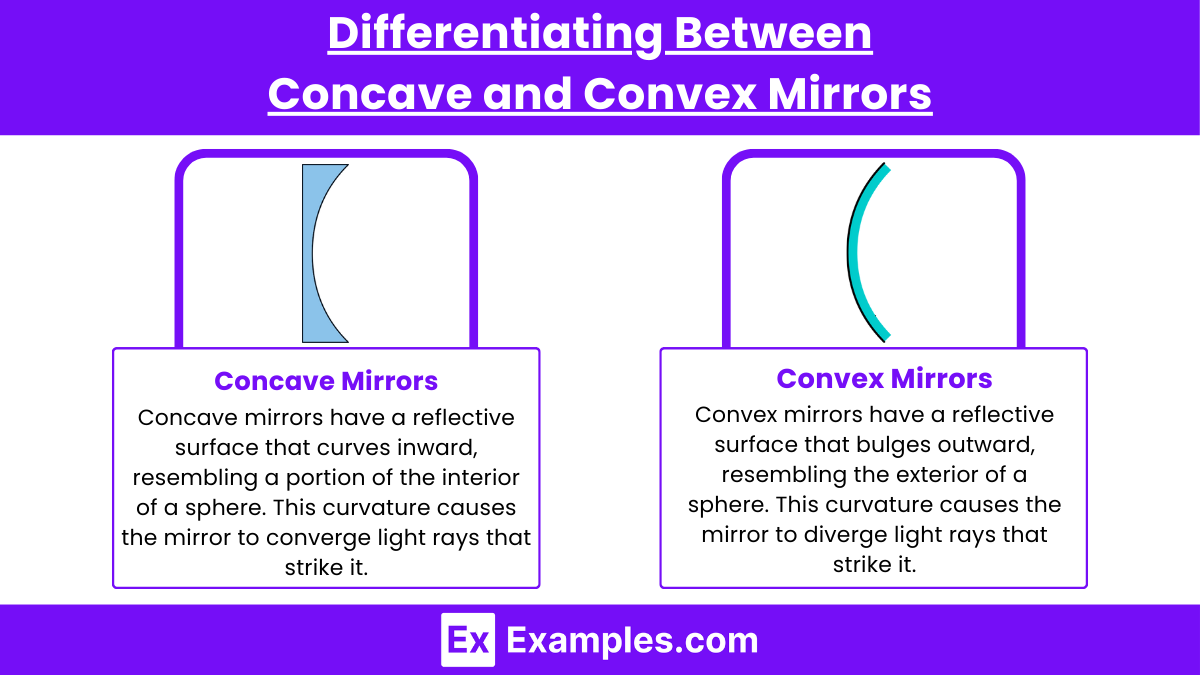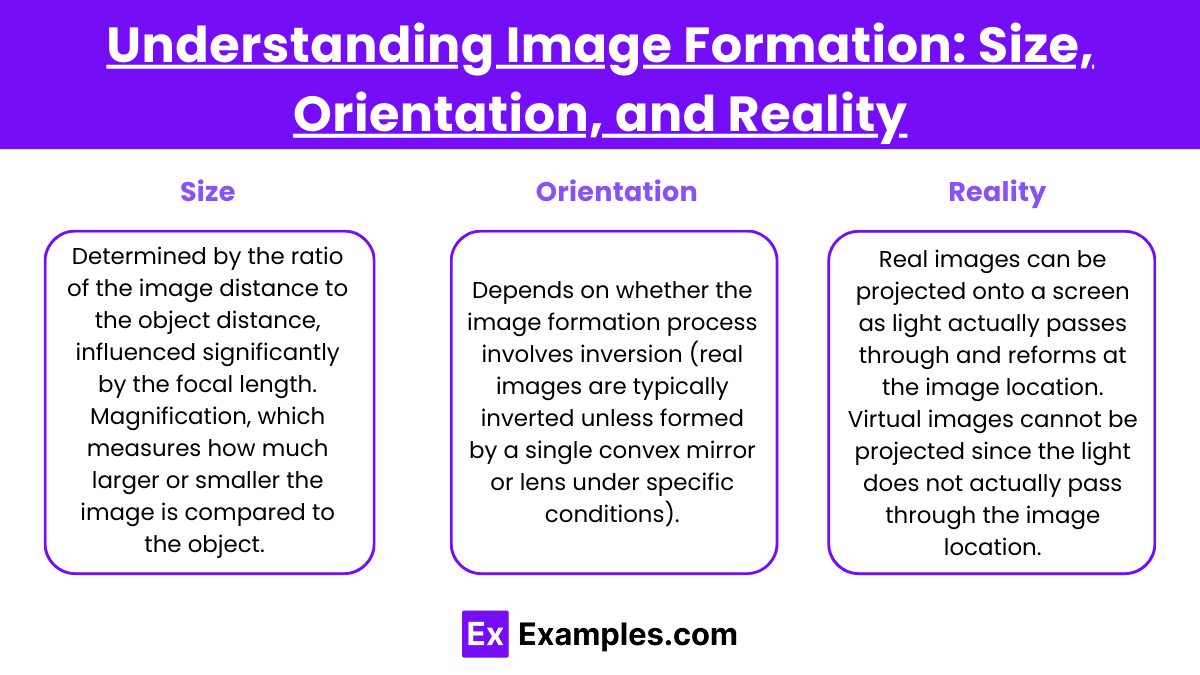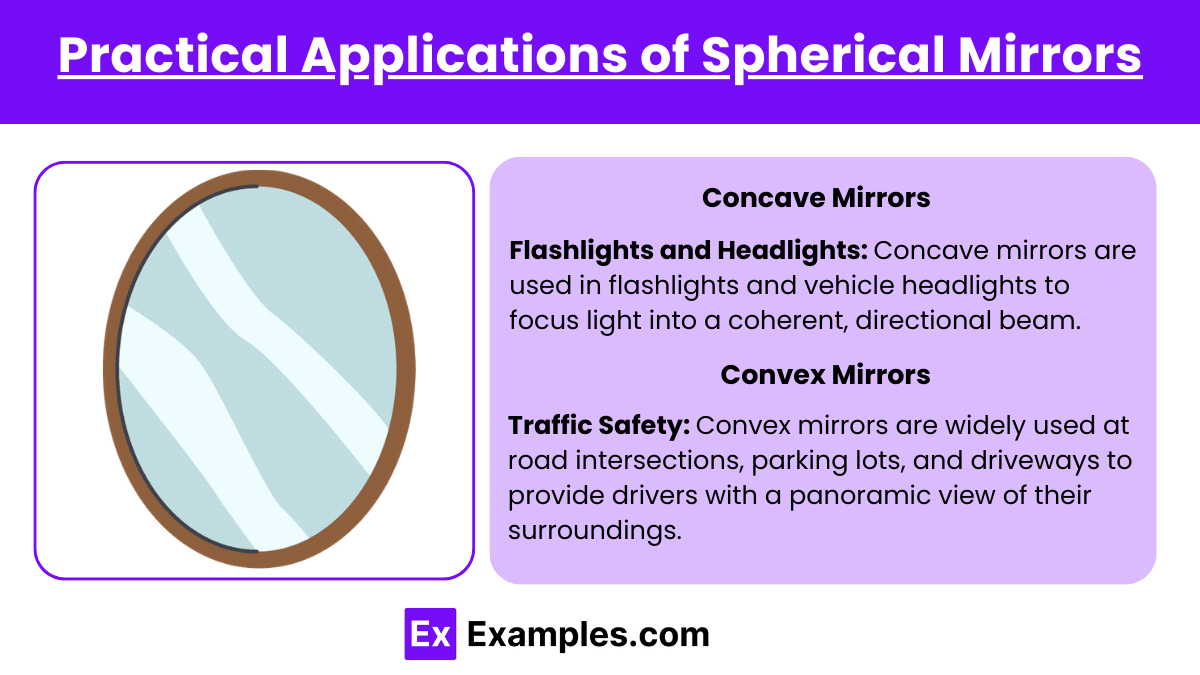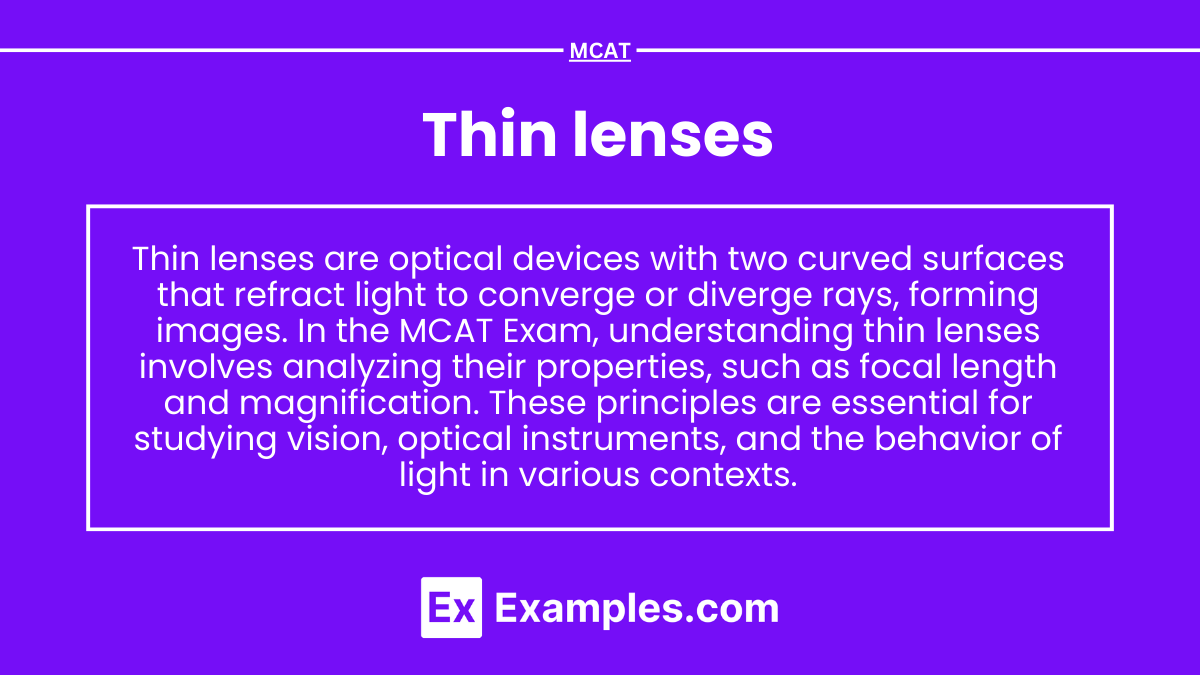Thin lenses are essential in understanding optical systems, playing a crucial role in focusing light and forming images. On the MCAT, you’ll explore the properties of converging and diverging lenses, image formation through ray diagrams, and the lens equation. Mastery of focal length, magnification, and lens combinations is vital, as these concepts are integral to the physics section of the exam, bridging knowledge between physical optics and real-world applications.
Learning Objectives
In studying “Thin Lenses” for the MCAT, you should learn to distinguish between converging and diverging lenses, understanding their structure, focal points, and behavior with light rays. Familiarize yourself with lens-related terms, including focal length, principal axis, and optical center. Apply the thin lens equation to solve for image distance, focal length, and object distance. Understand the concept of magnification and use the magnification formula to determine image size and orientation. Analyze how real and virtual images are formed, their characteristics, and the sign conventions involved. Evaluate lens applications in the human eye, microscopes, and cameras, focusing on how they relate to vision correction and optical instruments. Additionally, practice solving physics-based problems involving multiple lenses and ray diagrams to predict image properties accurately.
Differentiating Between Concave and Convex Mirrors

Concave and convex mirrors are types of curved mirrors used in various optical devices. They differ in shape and the manner in which they reflect light, which directly affects their applications. Understanding their differences is crucial for correctly implementing them in practical scenarios like vehicle mirrors, telescopes, and architectural lighting.
Concave Mirrors (Converging Mirrors)
Shape: Concave mirrors have a reflective surface that curves inward, resembling a portion of the interior of a sphere. This curvature causes the mirror to converge light rays that strike it.
Focal Point:
- A concave mirror converges light rays to a focal point in front of the mirror when the incoming rays are parallel to the principal axis (the straight line perpendicular to the center of the mirror).
- The focal point is the point where light rays converge and images can form.
Convex Mirrors (Diverging Mirrors)
Shape: Convex mirrors have a reflective surface that bulges outward, resembling the exterior of a sphere. This curvature causes the mirror to diverge light rays that strike it.
Focal Point:
- Convex mirrors cause parallel light rays to spread out (diverge) after reflecting off the mirror. The rays appear to originate from a focal point behind the mirror.
- The focal point is virtual and cannot be reached by the light rays physically.
Understanding Image Formation: Size, Orientation, and Reality

Understanding how images are formed by optical devices like lenses and mirrors is crucial for applications ranging from photography and eyewear to scientific instruments. The characteristics of these images—size, orientation, and whether they are real or virtual—depend significantly on the object’s position relative to the device and the specific properties of the device (like focal length and shape).
Image Formation by Lenses
Lenses bend light through refraction, converging or diverging rays to form images. They are classified as either convex (converging) or concave (diverging).
- Convex Lenses: When parallel rays of light pass through a convex lens, they converge at a point called the focal point. The nature of the image depends on the object’s position relative to the focal length:
- Object outside the focal length: Produces a real, inverted image on the opposite side of the lens.
- Object at the focal length: No real image is formed; rays emerge parallel.
- Object inside the focal length: Produces a virtual, upright, and magnified image on the same side as the object.
- Concave Lenses: These lenses diverge light rays such that they appear to originate from a point on the object’s side of the lens. Concave lenses always produce virtual, upright, and reduced images, regardless of the object’s position.
Image Formation by Mirrors
Mirrors reflect light, forming images through the angle of incidence equaling the angle of reflection. Mirrors can be flat, concave, or convex.
- Flat Mirrors: Always produce virtual, upright images of the same size as the object, located as far behind the mirror as the object is in front.
- Concave Mirrors: These mirrors can form various types of images based on the object’s distance from the mirror:
- Object beyond the center of curvature: Real, inverted, and smaller image between the center of curvature and the focal point.
- Object at the center of curvature: Real, inverted image of the same size at the center of curvature.
- Object between center of curvature and focal point: Real, inverted, and magnified image beyond the center of curvature.
- Object at the focal point: No real image is formed.
- Object between focal point and mirror: Virtual, upright, and magnified image.
- Convex Mirrors: Always produce virtual, upright, and smaller images regardless of the object’s position relative to the mirror.
General Principles of Image Formation
- Size: Determined by the ratio of the image distance to the object distance, influenced significantly by the focal length. Magnification, which measures how much larger or smaller the image is compared to the object, is calculated as M = −i/o, where i is the image distance and o is the object distance.
- Orientation: Depends on whether the image formation process involves inversion (real images are typically inverted unless formed by a single convex mirror or lens under specific conditions).
- Reality: Real images can be projected onto a screen as light actually passes through and reforms at the image location. Virtual images cannot be projected since the light does not actually pass through the image location; it only appears to do so.
Practical Applications of Spherical Mirrors

Spherical mirrors, which include both concave and convex types, are used extensively across various fields due to their unique optical properties. These mirrors are segments of a sphere and reflect light in specific ways that are useful for focusing, diverging light, or capturing wide views. Here’s a look at some practical applications of spherical mirrors:
Concave Mirrors (Converging Mirrors)
- Focusing Light:
- Flashlights and Headlights: Concave mirrors are used in flashlights and vehicle headlights to focus light into a coherent, directional beam. The bulb is placed at the focal point of the concave mirror to ensure that the light rays are projected as parallel rays outward.
- Telescopes:
- Astronomical Telescopes: Many optical telescopes use large concave mirrors to collect light from distant stars and galaxies and focus it to a point where an image can be observed or recorded. This is due to their ability to gather and focus parallel light rays from distant objects.
- Solar Furnaces:
- Large concave mirrors can focus sunlight onto a small area, generating high temperatures. This principle is used in solar furnaces for experimental purposes in science and for high-temperature industrial processes.
- Medical and Dental Use:
- Concave mirrors are used in ophthalmoscopes for examining the eye’s interior, and in dental mirrors to reflect light inside the mouth and magnify the images of the teeth for better visualization.
- Makeup and Shaving Mirrors:
- These mirrors are often concave to magnify the face for clearer and closer viewing during makeup application or shaving.
Convex Mirrors (Diverging Mirrors)
- Traffic Safety: Convex mirrors are widely used at road intersections, parking lots, and driveways to provide drivers with a panoramic view of their surroundings, reducing blind spots and preventing accidents.
- Surveillance in Stores: Convex mirrors are installed in retail stores and supermarkets to observe a larger area than can be seen directly by store personnel, helping to monitor customers and deter theft.
- Hallway Safety in Buildings: In schools, hospitals, and office buildings, convex mirrors are used in hallways and near corners to prevent collisions by providing a view around corners.
- Vehicle Side Mirrors: The side mirrors on cars and other vehicles are often convex to provide a wider field of view than a flat mirror could offer, helping drivers see other vehicles that might otherwise be hidden in their blind spots.
Architectural and Artistic Uses
- Decorative Purposes: Both concave and convex mirrors are used in interior design and art installations to manipulate light and space visually, creating unique visual effects and illusions.
- Architectural Design: Architects may use spherical mirrors to focus light or provide expansive views within a building, enhancing natural lighting or the aesthetic appeal of the space.
Examples
Example 1: Camera Lenses
Thin lenses are integral components of camera systems, where they focus light onto a sensor or film. For example, a convex lens in a camera allows for the creation of sharp images by converging light rays from a scene. The lens’s focal length determines how close or far away objects can be captured in focus, illustrating the practical application of thin lenses in photography.
Example 2: Eyeglasses
Thin lenses are commonly used in prescription eyeglasses to correct vision. Concave lenses are employed for nearsightedness, helping to diverge light rays so that they focus correctly on the retina. Conversely, convex lenses are used for farsightedness, converging light rays to ensure that images are properly focused. This application demonstrates how thin lenses can enhance visual clarity.
Example 3: Magnifying Glass
A magnifying glass utilizes a convex thin lens to produce a magnified image of an object. When an object is placed within the focal length of the lens, the light rays are refracted to create a larger, upright image. This principle is commonly used in reading small text or examining fine details, showcasing the utility of thin lenses in everyday tasks.
Example 4: Projector Lenses
In projectors, thin lenses are used to focus and enlarge images onto a screen. The lens arrangement ensures that light from a small image source is magnified and projected accurately. The design of the thin lens system allows for adjustments in focus and zoom, making it possible to display clear images in various settings, such as classrooms or theaters.
Example 5: Optical Instruments
Thin lenses are fundamental components in various optical instruments, such as microscopes and telescopes. In a microscope, a combination of thin convex lenses allows for the magnification of small specimens, enabling detailed observation of structures. Similarly, telescopes use thin lenses to gather and focus light from distant celestial objects, allowing astronomers to study them in greater detail. These applications highlight the versatility of thin lenses in advancing scientific exploration.
Practice Questions
Question 1
What type of lens is primarily used to correct nearsightedness (myopia)?
A) Convex lens
B) Concave lens
C) Bifocal lens
D) Cylindrical lens
Correct Answer: B) Concave lens.
Explanation: A concave lens is used to correct nearsightedness (myopia) because it diverges light rays before they enter the eye. This adjustment allows the light to focus further back on the retina, enabling clearer vision for distant objects. In contrast, a convex lens is used for farsightedness (hyperopia) as it converges light rays. Therefore, option B is correct.
Question 2
When an object is placed at a distance greater than the focal length of a convex lens, what type of image is produced?
A) Virtual and upright
B) Real and inverted
C) Real and upright
D) Virtual and inverted
Correct Answer: B) Real and inverted.
Explanation: When an object is positioned beyond the focal point of a convex lens, the lens converges the light rays, resulting in a real image that is inverted. This image can be projected onto a screen and appears upside down compared to the object. If the object is within the focal length, the image produced would be virtual and upright. Thus, option B is the correct answer.
Question 3
What effect does increasing the curvature of a thin lens have on its focal length?
A) Increases the focal length
B) Decreases the focal length
C) Has no effect on the focal length
D) Only affects concave lenses
Correct Answer: B) Decreases the focal length.
Explanation: Increasing the curvature of a thin lens effectively increases its optical power, which means the lens can bend light rays more sharply. As a result, the focal length decreases. A lens with a shorter focal length is more powerful and will converge or diverge light more quickly than a lens with a longer focal length. Therefore, option B is correct, as it accurately reflects the relationship between lens curvature and focal length.


